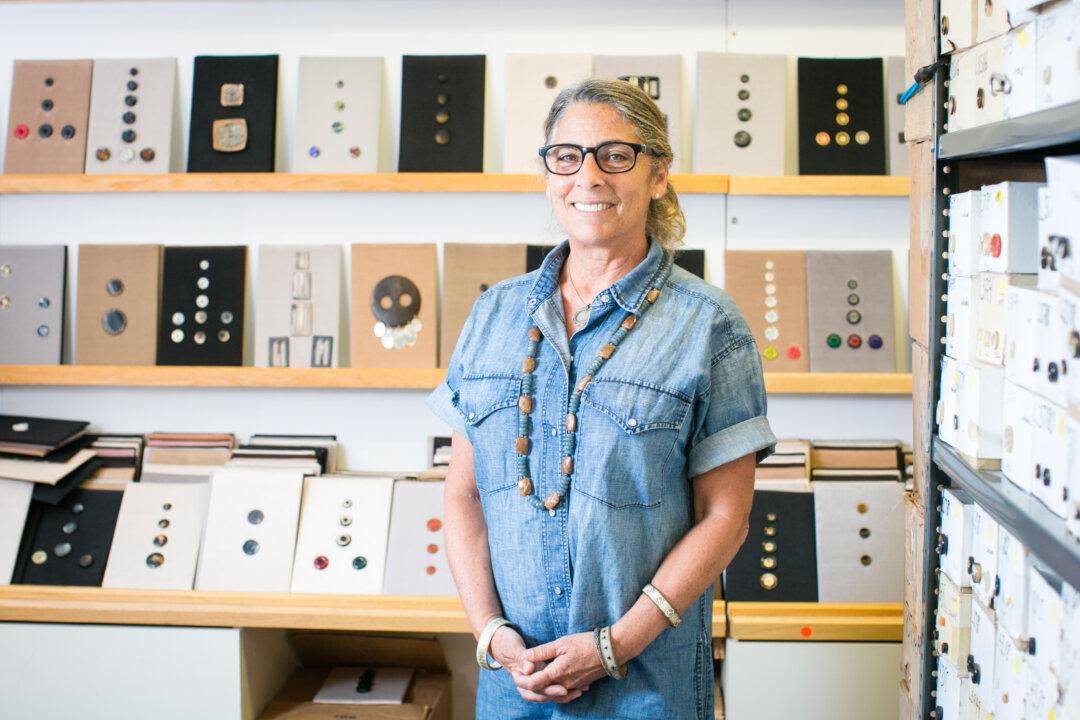NEW YORK—It’s a long stretch coming from Melbourne, Australia, where Ray Griffiths worked in his father’s shoe workshop, to his studio on 5th Avenue. His path was undoubtedly paved with, not so much blood, but definitely sweat, tears, and lots of gold, diamonds, and colorful gemstones.
“I was between 8 and 10 years old when I said ‘I wanna be a jeweler.’ I had no idea what I was talking about, but I loved everything sparkly,” he said.
Looking at the view that stretches all the way up 5th Avenue to Central Park, through his jewel-like arched copper window that dates back to the turn of the last century, Ray recalls his early days when he was an apprentice at Dunklings.
The Melbourne company with a history of jewelry making and hundred-year-old equipment took him in as only the second left-handed jewelry apprentice in the history of [the state of] Victoria. There, he learned traditional techniques. He quickly silenced his critics who thought that he was “really useless” by completing well all the tasks that he was given, learning patience and attention to detail.
The Forging of Ray
“We would get original pieces coming in and [the staff] would look through the books and the catalogs of when it was made—like 1900 or 1885—and they might still have notes on it and drawings. So if it was worn out we would have to replicate it exactly the same way,” Griffiths said.
As a result, his own work reflects his respect for traditional techniques combined with a modern aesthetic that comes out of his mastery of the craft rather than design. In fact, Griffiths is adamant that he is first and foremost a craftsman.
“I still don’t say [that] I’m a designer. I’m a man with a hammer in my hand. The design has come out of the craft.”
Coming to New York City
While still new to New York City, Griffiths was told that in order to really stand out here he needed to come up with something that nobody else had. He started experimenting with crown work and doing it in different variations, finally realizing that the diamond-shaped grid pattern suited his sensibility—somewhat architectural and very informed by jewelry techniques that span ages and continents.
According to Griffiths, his work contains an enormous amount of detail that harks back to the Ottoman Empire as well as 17th-, 18th-, and 19th-century European work.
“The history of the jewelry world is in a lot of these,” Griffiths said.
When it comes to gemstones, Griffiths confesses to being “a lunatic.”
He finds it hard to contain his excitement and produces a very rare lavender tourmaline from Mozambique that he has been keeping for years. We examine the scintillating stone to look for the inclusions that Griffiths insists are what gives it character. Looking at such beauty, it is easy to see how one can fall in love with it.
The way he selects a stone is by looking for the inclusions, the “road map that identifies it and gives it a special characteristic.”
In the small workshop that Griffiths calls “a couture house for jewelry,” a love of stones is a prerequisite that somehow gets transmitted through to the finished product. Somehow, when you hold Griffiths’s creations, there is a warmth and a joy that is a perfect reflection of the man himself.
“Jewelry means something. We all have things that are given to us that are very precious. My obligation is to make a beautiful thing that is going to be given as a gift that will have a great deal of meaning and that will last a lifetime, or multiple lifetimes,” Griffiths said.
I met him after coming back to New York from a trunk show in Chicago. A collection of multicolored rings was laid out onto a black velvet cloth, the contrast making them look like precious jelly beans.
Analyzing Loveliness of Gemstones
Griffiths spares no detail in describing the uniqueness of each of his “beloved gems.” There is pure mint green chrysoprase—a stone that is only found in Australia, delicious-looking apple-green peridot, pave diamonds that sparkle as only diamonds can, and Griffiths also shows a pave ring set with very rare, natural color-changing garnets.
A short lesson ensues on how lights travel at different speeds through the garnet and how cutting the stones a certain way achieves maximum effect; Griffiths’s enthusiasm and patient explanation make the whole concept fully understandable and infectiously interesting. One would never get tired looking at gemstones, and the knowledge of their unique provenance makes them even more covetable.
The juxtaposition of the stones set against the diamond-shaped grid pattern highlights each stone to full effect not just in terms of its contrasting roundness with the geometry of the metalwork but also in color. This is jewelry as it should be—lovingly created, piece by piece, imbued with the spirit of its maker and its own unique story to tell.
The Terror of Opals
I remark on the curious absence of opals that can be found in great abundance and colors in Australia. Upon my comment Griffiths cheerfully confesses to an unfortunate incident at the age of 15 in his first month as an apprentice at Dunklings.
He was given opal cabochon that belonged to a customer. In the process of admiring it, the stone fired out of Ray’s hands and landed on the floor, breaking in two pieces.
“Management was screaming at me. So since that day I’ve been terrified of opals,” he said. This would be one of life’s formative inclusions that have forged Ray’s work over 30 years.
Of his own crownwork ring set with a natural and rare spessartine garnet he says, “It’s just a beautiful, happy stone.” A befitting description that seems to encapsulate more than just the ring itself.




